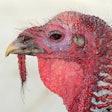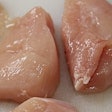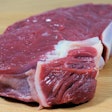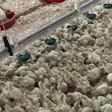
Pig producers are in a good spot currently and in the near term thanks to a favorable export market for pork, according to Steve Meyer, vice president of pork analysis for Express Markets Inc. Analytics, who provided an economic update for the pig industry on June 8 at World Pork Expo in Des Moines, Iowa.
Exports – up 14.6 percent so far in 2017 in terms of carcass weight equivalent – remain key to the pork industry, and a weakening dollar is expected to continue to fuel pork exports through the rest of the year.
With a projected 23-24 percent of pork to be shipped to foreign markets in 2018, this significant export revenue underscores the need for a foot-and-mouth disease (FMD) vaccine bank, he emphasized, which the industry has been lobbying for in the Farm Bill.
“If we export 23.4 percent and something happens and that stays here, that actually increases our domestic availability by 33 percent,” said Meyer. … “That would take retail prices down 60 something percent – that wouldn’t be good. It would be a very, very ugly situation.”
Profitable economic conditions for producers
Increased demand for pork both domestically and internationally has producers around the U.S. ramping up their capacity and a number of new plants coming online over the next year. Meyer said slaughter is up 3.8 percent from 2017 and is projected to rise 4 percent in 2018, with the sow herd up 1.5-2 percent year over year.
Additionally, three good crop cycles in a row mean that pork producers are expected to break even or profit in the coming year with lower feed costs, according to Meyer. Although futures are slightly optimistic for the summer months, he says pricing opportunities are good for producers. He projects that the average producer will make a profit of $10 per head, with exceptional producers profiting near $20 per head.
Consumption of pork, according to Meyer, is expected to continue trending upward, returning to 2006 levels of 220 pounds in 2019.
“I didn’t think we’d ever get back there, but we certainly are, it looks like,” he said.
Areas of concern
While the economic outlook for pig producers is mostly positive in the short term, Meyer pointed to a few challenges that producers should be aware of.
One area of concern he noted was the lower number of hogs available on the negotiating market, which is down to about 2.3 percent thus far in 2017.
“[This] doesn’t mean that those prices that are being discovered are inaccurate, it just means there’s more of a chance of mismatch between the fringe supply and fringe demand for that … and producers are the ones who have to decide to solve that problem,” Meyer said.
Slaughter weights have also been lower than a year ago, which was partially anticipated due to a tight slaughter situation in fall 2016, but also because fewer hogs are being fed ractopamine, and so, these pigs are growing slower. Since packing plants are more efficient with larger pigs, he said producers have incentive to bring these hogs back up to higher weights of previous years once an alternative solution to using as many growth promoters is found.
A last area of concern that Meyer pointed to was competition from other meats, namely beef.
“We think the beef industry is set up for a real crash here this summer,” he said. “… There’s a lot of long-fed cattle coming to market, and so that’s a big risk in our mind.”

















